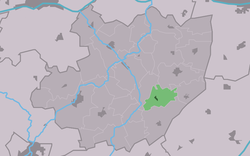Wiuwert
Wieuwerd
Wiuwert | |
|---|---|
Village | |
 Wieuwerd church | |
 Flag  Coat of arms | |
 Location in the former Littenseradiel municipality | |
 Wieuwerd Location in the Netherlands | |
| Coordinates: Coordinates: 53°6′32″N 5°41′24″E / 53.10889°N 5.69000°E | |
| Country | Netherlands |
| Province | Friesland |
| Municipality | Súdwest-Fryslân |
| Population (2017) | |
| • Total | 277 |
| Time zone | UTC+1 (CET) |
| • Summer (DST) | UTC+2 (CEST) |
| Postal code | 8637 |
| Telephone area | 058 |
Wiuwert (Dutch: Wieuwerd) is a village in Súdwest-Fryslân municipality in the province of Friesland, the Netherlands. It had a population of around 277 in January 2017.[1]
History[]
Before 2018, the village was part of the Littenseradiel municipality and before 1984 it belonged to Baarderadeel municipality.
Labadist community[]
After the death of the pietist Jean de Labadie in 1674, his followers set up a community in Wieuwerd at the stately Walt(h)a Castle that belonged to three of them, the sisters Van Aerssen van Sommelsdijck.[2] Here, the Labadists engaged in printing and many other occupations, including farming and milling. The original settlers included the famed poet, painter and scholar Anna van Schurman, who died in Wieuwerd in 1678. One member, Hendrik van Deventer,[3] skilled in chemistry and medicine, set up a laboratory at the house and treated many people, including Christian V, the King of Denmark. Several other noted visitors have left their accounts of visits to the Labadist community. One was Sophie of Hanover, mother of King George I of Great Britain; another was William Penn, the Quaker pioneer, who gave his name to the US state of Pennsylvania; a third was the English philosopher John Locke.[4] Between 1685 and 1691, the naturalist and scientific illustrator Maria Sibylla Merian stayed at the community in Wieuwerd with her daughters Johanna Helena and Dorothea Maria. Merian's husband was refused by the Labadists, but came back twice.[5]
Several Reformed pastors left their parishes to live in community at Wieuwerd. At its peak, the community numbered around 600 with many more adherents further afield. Visitors came from England, Italy, Poland and elsewhere, though not all approved of the strict discipline, separatism and community property.[5] The community lasted until 1730.
Mummies[]
The basement of the Nicolas Church of Wiuwert houses four natural mummies dating back to the beginning of the seventeenth century. In the year 1609, the noble Walta family had a crypt built beneath the church for them to be buried in. Some members of the aforementioned Labadist community were also buried in the crypt. In the year 1765, construction crew accidentally rediscovered this crypt with its very well preserved bodies: the bodies were still wearing clothes, and they looked like they had just been buried.[6]
So far, scientist have been unable to pinpoint the cause of the mummification of the bodies. Contributing factors such as the constant low temperature, high humidity and continuous airflow have been mentioned, but never proven.[7]
The identity of the mummies is similarly unclear. The four mummies are one young girl (aged 14) that died around 1610 from tuberculosis, a woman that died a peaceful death around 1618, a man who died a painful death due to a dental abscess, and the gold smith Stellingwerf who appears to have died peacefully and was the last to be buried around the year 1705.[8]
References[]
- ^ Aantal inwoners per dorp - Littenseradiel
- ^ Details on the Waltha or Thetinga estate Drawing and map of the estate by Johann Andreas Graff, Merian's husband
- ^ van der Weiden RM, Hoogsteder WJ (October 1997). "A new light upon Hendrik van Deventer (1651-1724): identification and recovery of a portrait". J R Soc Med. 90 (10): 567–9. PMC 1296602. PMID 9488017.
- ^ Glausser, Wayne (1998). Locke and Blake: a conversation across the eighteenth century. Gainesville: University Press of Florida. pp. 23–4. ISBN 0-8130-1570-7.
- ^ Jump up to: a b Wolfgang Klötzer (Hrsg.): Frankfurter Biographie. Zweiter Band M–Z. Verlag Waldemar Kramer, Frankfurt am Main 1996, ISBN 3-7829-0459-1
- ^ Official website of the mummy crypt
- ^ Official website of the mummy crypt
- ^ Official website of the mummy crypt
External links[]
![]() Media related to Wiuwert at Wikimedia Commons
Media related to Wiuwert at Wikimedia Commons
- Súdwest-Fryslân
- Populated places in Friesland
- Friesland geography stubs

